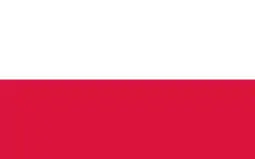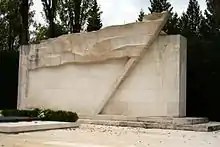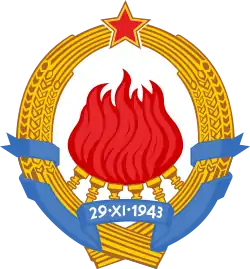Order of the People's Hero
The Order of the People's Hero[3][4][5] or the Order of the National Hero[6][7] Serbo-Croatian: Orden narodnog heroja / Oрден народног хероја; Slovene: Red narodnega heroja, Macedonian: Oрден на народен херој, romanized: Orden na naroden heroj), was a Yugoslav gallantry medal, the second highest military award, and third overall Yugoslav decoration.[1] It was awarded to individuals, military units, political and other organisations who distinguished themselves by extraordinary heroic deeds during war and in peacetime. The recipients were thereafter known as People's Heroes of Yugoslavia or National Heroes of Yugoslavia. The vast majority was awarded to partisans for actions during the Second World War. A total of 1,322 awards were awarded in Yugoslavia, and 19 were awarded to the foreigners.[8]
| Order of the People's Hero | |
|---|---|
 Order of the People's Hero medal and ribbon bar | |
| Type | Medal |
| Awarded for | Distinguishing oneself by extraordinary heroic deeds |
| Presented by | |
| Status | Incepted |
| First awarded | 1942 |
| Last awarded | 1991 (Milan Tepić) |
| Total | Around 1,400 |
ribbon | |
| Precedence | |
| Next (higher) | Order of Freedom |
| Next (lower) | Order of the Hero of Socialist Labour (1948–1992)[1] Order of the Yugoslav Flag (1998–2006)[2] |

In 1998, the Federal Republic of Yugoslavia decided to award the Order of the People's Hero again and decorated several military units, but no individuals.
History
Socialist Yugoslavia
The bulletin of the Supreme command of the People's Liberation Army of Yugoslavia no. 12–13 (December 1941 and January 1942) announced the establishment of the title of "People's Hero" for heroic and self-sacrificing participants of the People's Liberation War. The first person to be awarded the title was Petar Leković. A total of 22 persons were awarded this title. On 15 August 1943, the title was formalized as an order together with Order of the People's Liberation, Order of Bravery, Order of the Partisan Star, Order of Brotherhood and Unity and the Medal for Bravery. At the same time, all the persons who already held the title of the People's Hero were awarded the order.[9]
The Order consists of an oval gold badge showing a soldier with rifle and banner superimposed upon a rayed star surrounded by a wreath of laurel. The badge is suspended from a red ribbon, with a narrow white stripe towards each edge. The design for this and the other Orders were undertaken by the painter Đorđe Andrejević Kun and the sculptor Antun Augustinčić. Before 29 November 1943, the title of People's Hero was awarded by the Central Comity of KPJ, after 1945 it was awarded by the Presidium of the People's Assembly of Yugoslavia, and starting in 1953 by the President of Yugoslavia.[9]
From its inception until around 1993, the Order had been awarded nearly 1,400 times. Marshal Josip Broz Tito was awarded the Order three times: in 1944, 1972 and 1977. The holders of the order were entitled to certain benefits, like free fares on public transport, and pensions for the surviving family members of deceased people's heroes. Although the benefits have since been downscaled, post-Yugoslav countries still provide certain benefits to people's heroes. Many schools and streets in post-war Yugoslavia were named after people's heroes, and many of the names remain, to varying degrees in different successor countries.
Not only people, but cities, military units and organizations were also awarded the order. Eight cities in Yugoslavia were awarded the order and proclaimed "hero cities": Belgrade, Cetinje, Drvar, Ljubljana, Novi Sad, Prilep, Pristina, and Zagreb.[9]
Serbia and Montenegro
Following the dissolution of SFR Yugoslavia, Federal Republic of Yugoslavia was formed, and later renamed Serbia and Montenegro. In 1998, it passed a law that continued to use some of the decorations of former Yugoslavia, among them Order of the People's Hero,[10] making it the fourth highest order after the Order of Yugoslavia, Order of the Yugoslav Star and the Order of Freedom.[2]
The Serbian media ridiculed several proposals to decorate Slobodan Milošević with the Order of the People's hero because he would have had to decorate himself.[10][11] It was never given to any individuals, but several military units active in the Kosovo War were decorated:[11]
- 124th Police Intervention Brigade, Serbian Ministry of Internal Affairs
- 126th Brigade for Air Reconnaissance, Military of Yugoslavia
- 250th Air Defence Missile Brigade, Military of Yugoslavia
- 37th Motorized Brigade, Military of Yugoslavia
Notable recipients

Notable recipients of the order include:
- Božidar Adžija
- Vlado Bagat
- Vladimir Bakarić
- Antun Blažić
- Josip Broz Tito
- Marija Bursać
- Boško Buha
- Rade Bulat
- Anka Butorac
- Rudi Čajavec
- Rodoljub Čolaković
- Krste Crvenkovski
- Peko Dapčević
- Nada Dimić
- Robert Domany
- Petar Drapšin
- Stjepan Filipović
- Ivan Gošnjak
- Petar Gračanin
- Većeslav Holjevac
- Lizika Jančar
- Blagoj Jankov
- Žikica Jovanović
- Edvard Kardelj
- Boris Kidrič
- Franjo Kluz
- Lazar Koliševski
- Rade Končar
- Sava Kovačević
- Josip Kraš
- Vicko Krstulović
- Nikola Ljubičić
- Vahida Maglajlić
- Veselin Masleša
- Maks Baće Milić
- Miloš Minić
- Kosta Nađ
- Nada Naumović
- Marko Orešković
- Boško Palkovljević
- Moša Pijade
- Koča Popović
- Janko Premrl
- Ognjen Prica
- Slobodan Princip
- Lepa Radić
- Vladimir Rolović
- Ivo Lola Ribar
- Velimir Škorpik
- Slavko Šlander
- Mika Špiljak
- Drago Štajnberger
- Mladen Stojanović
- Milan Tepić
- Hristijan Todorovski
- Veljko Vlahović
- Rada Vranješević
- Majda Vrhovnik
- Svetozar Vukmanović
- Žarko Zrenjanin
 President Tito with People Heroes from Socialist Republic of Bosnia and Herzegovina
President Tito with People Heroes from Socialist Republic of Bosnia and Herzegovina President Tito with People Heroes from Socialist Republic of Montenegro
President Tito with People Heroes from Socialist Republic of Montenegro President Tito with People Heroes from Socialist Republic of Croatia
President Tito with People Heroes from Socialist Republic of Croatia President Tito with People Heroes from Socialist Republic of Slovenia
President Tito with People Heroes from Socialist Republic of Slovenia President Tito with People Heroes from Socialist Republic of Serbia and Socialist Republic of Macedonia
President Tito with People Heroes from Socialist Republic of Serbia and Socialist Republic of Macedonia
Foreign citizens recipients of the order
 Georgy Beregovoy
Georgy Beregovoy Sergey Biryuzov
Sergey Biryuzov Ivan Bulkin
Ivan Bulkin Andrey Vitruk
Andrey Vitruk Pavel Dmitrienko
Pavel Dmitrienko Vladimir Zhdanov
Vladimir Zhdanov Michał Żymierski
Michał Żymierski Pavel Yakimov
Pavel Yakimov Boris Kalinkin
Boris Kalinkin Semyon Kozak
Semyon Kozak Ivan Konstantinov
Ivan Konstantinov Luigi Longo
Luigi Longo Rodion Malinovsky
Rodion Malinovsky Alexander Managadze
Alexander Managadze Grigoriy Ohrimenko
Grigoriy Ohrimenko Ludvík Svoboda
Ludvík Svoboda Vladimir Sutetz
Vladimir Sutetz Fyodor Tolbukhin
Fyodor Tolbukhin Vasiliy Ulisko
Vasiliy Ulisko Alexander Shornikov
Alexander Shornikov
Hero Cities

Public and political organizations recipients of the order
World War II military units recipients of the order
- 1st Proletarian Strike Brigade[15]
- 2nd Proletarian Strike Brigade
- 3rd Proletarian (Sandžak) Strike Brigade
- 4th Proletarian (Montenegrin) Strike Brigade
- 5th Proletarian (Montenegrin) Strike Brigade
- 6th Proletarian (East Bosnian) Strike Brigade
- 1st Lika Proletarian Strike Brigade
- 2nd Lika Proletarian Strike Brigade
- 3rd Lika Proletarian Strike Brigade
- 1st Krajina Proletarian Strike Brigade
- 3rd Krajina Proletarian Strike Brigade
- 7th Krajina Strike Brigade
- 1st Dalmatian Proletarian Strike Brigade
- 2nd Dalmatian Proletarian Strike Brigade
- 3rd Dalmatian Strike Brigade
- 12th Slavonian Proletarian Strike Brigade
- 13th Proletaraian Strike Brigade "Rade Končar"
- 1st Slovenian Proletarian Brigade "Tone Tomšič"
- 2nd Slovenian People's Liberation Strike Brigade "Ljubo Šercer"
- 10th Herzegovinian Strike Brigade (after 1952: 17th Proletarian)
- 1st Vojvodina Strike Brigade (after 1958: 18th Proletarian)
- 1st Macedonian Proletarian Strike Brigade
- 3rd Serbian Proletarian Brigade
- 7th Banijan Strike Brigade "Vasilj Gačeša"
- 8th Banijan Strike Brigade
- 16th Banijan Strike Brigade
- 15th Majevica Strike Brigade
- 2nd Krajina People's Liberation Partizan Regiment "Dr Mladen Stojanović"
- Side Battalion of the Supreme Command of People's Liberation Army of Yugoslavia
- Workers' Battalion of the Užice People's Liberation Partizan Regiment
- Central Hospital of People's Liberation Army of Yugoslavia
- Partizan Hospital on Petrova Gora
- Security and Intelligence Service (Varnostno-obveščevalna služba)
Statistics

A total of 1,322 persons were awarded in Yugoslavia by 1981. Most of the awarded were men (1231) and 91 were women. Most People's Heroes were either miners or industrial workers (34%), 19% were university and high school students, 18% were farmworkers and 13% were experts of all kinds.[8]
Most of the awarded were very young. Half of them joined the Army before the 25th birthday, and only 325 of them were over 30. 42% of the Heroes who died in the war were between 16 and 26 years old, 38% were between 27 and 34. Three Heroes were less than 17 years old when they died. Milka Bosnić was the youngest recipient of the order, she was just 15 when killed during the Raid on Drvar.[8]
Most recipients were awarded in the years following the World War II, most of them between 1951 and 1953. Tito was the only person to be awarded multiple times, he was awarded the order three times. Of the 955 recipients who died in the war, 77% were killed in combat, about 15% was executed or died in prison, and about 7% died from wounds. Most of the Heroes died in 1943 (about 30%) and in 1942 (27.5%). Nine of them were killed after the war officially ended during the fight with remaining enemy forces. 55 People's Heroes committed suicide to escape arresting.[8]
Most of the recipients of the Order were born in Croatia (21.9%), than in Bosnia and Herzegovina (20.6%), Montenegro (18.7%), Central Serbia (15%) and 11.05% were born in Slovenia. Most of those who died during the World War II died in Bosnia and Herzegovina (32%). In 1957 there were 410 living People's Heroes, in 1975 there were 367, and in 1981 there were 343 living Heroes.[8]
See also
- Orders and medals of Socialist Yugoslavia
- Orders and medals of Federal Republic of Yugoslavia
- Hero of the Soviet Union
- Hero of Albania
- Hero of the Czechoslovak Socialist Republic
References
- Narodni heroji Jugoslavije (People's Heroes of Yugoslavia), "Mladost", Belgrade, 1975 (in Serbo-Croatian)
- Encyclopedia (1982). Narodni heroji Jugoslavije (People's Heroes of Yugoslavia) (in Serbo-Croatian). Belgrade and Titograd: Partizanska knjiga, Narodna knjiga, Pobjeda.
- Orders and Decorations of the Socialist Federal Republic of Yugoslavia, 1945-90 by Lukasz Gaszewski 2000, 2003
- Orders and Decorations of the Federal Republic of Yugoslavia, 1990- by Lukasz Gaszewski 2000, 2003
- Encyclopedia Americana, volume 8. New York: Grolier. 1984. p. 608. Retrieved November 2, 2018.
- Ruggenthaler, Peter (2015). The Concept of Neutrality in Stalin's Foreign Policy, 1945–1953. Lanham, MD: Lexington Books. p. 99. Retrieved November 2, 2018.
- Rosen, David M. (2015). Child Soldiers in the Western Imagination: From Patriots to Victims. New Brunswick, NJ: Rutgers University Press. Retrieved November 2, 2018.
- "Yugoslavia Honors Dead Soviet Officer". Star Tribune. October 21, 1964. p. 12. Retrieved November 2, 2018 – via Newspapers.com.

- "Yugoslavia Honors Tito as 'Hero' for Third Time". The Los Angeles Times. May 17, 1977. p. 9. Retrieved November 2, 2018 – via Newspapers.com.

- Encyclopedia, volume 2, page 463
- Encyclopedia, volume 1, page 7
- "Zakon o odlikovanjima". Vreme (in Serbian). 1999-04-24. Retrieved 2012-02-10.
- "Milošević bi morao sam sebe da odlikuje". Blic (in Serbian). 2000-06-08. Retrieved 2012-02-10.
- Encyclopedia, volume 2, page 432
- Encyclopedia, volume 2, page 431
- Encyclopedia, volume 2, page 434
- Encyclopedia, volume 2, page 407
External links
| Wikimedia Commons has media related to Order of the National Hero. |
- ZAKON O OSNOVNIM PRAVIMA LICA ODLIKOVANIH ORDENOM NARODNOG HEROJA (Law on Basic Rights of Persons Awarded the Order of the People's Hero) (in Serbo-Croatian)
- Narodni heroji Jugoslavije (People's Heroes of Yugoslavia) (in Serbo-Croatian)
- Narodni heroji (People's Heroes) (in Serbo-Croatian)

